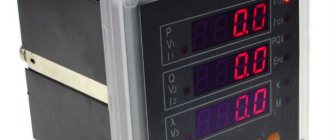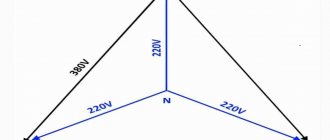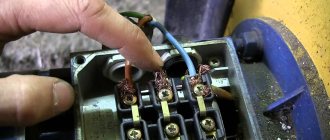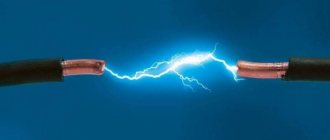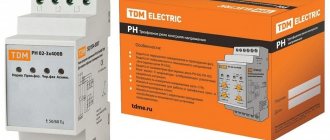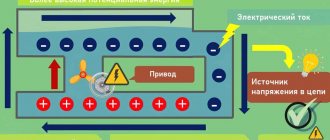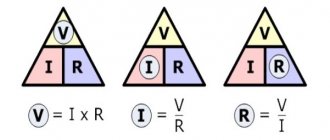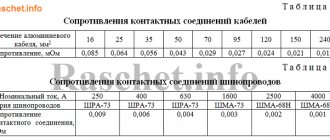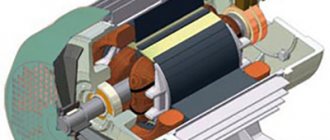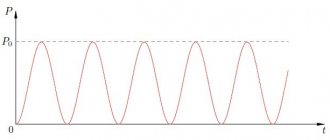Household electrical distribution networks mainly use one phase and a neutral conductor. This is enough to operate household electrical appliances, lighting and heating. To organize the production process, three-phase current is used. Consumers, busbar assemblies, distribution panels, metering units and the entire electrical circuit are configured to operate from three-phase current networks.
Three-phase current
What is a three-phase network?
Before putting into operation, any house or apartment is connected to the local power grid. Such a network can be single-phase or three-phase. With a single-phase connection, two wires are supplied to the house, a phase and a zero, between which the voltage is 220 V. A three-phase network is characterized by the presence of four wires: three phases and a zero. Between each phase and zero the voltage is 220 V, and between the phases themselves 380 V (as shown in the image).
To account for electricity in such a network, a three-phase meter is required, which is installed by the local distribution zone. A typical example of such a meter is INCOTEX Mercury 231 AM-01, designed for metering active electricity.
Advantages and disadvantages
Both power systems have their pros and cons, which change places or become insignificant when the power passes the 10 kW threshold. I'll try to list.
Single-phase network 220 V, advantages
- Simplicity
- Cheapness
- Below dangerous voltage
Single-phase network 220 V, cons
- Limited consumer power
Three-phase network 380 V, advantages
- Power is limited only by wire cross-section
- Savings with three-phase consumption
- Power supply for industrial equipment
- Possibility of switching a single-phase load to a “good” phase in case of deterioration in quality or power failure
Three-phase network 380 V, cons
- More expensive equipment
- More dangerous voltage
- Limits the maximum power of single-phase loads
How are three phases different from one?
In both types of power there is a working neutral conductor (ZERO). I talked in detail about protective grounding here; it is a broad topic. In relation to zero in all three phases - the voltage is 220 Volts. But in relation to these three phases to each other, they have 380 Volts.
Voltages in a three-phase system
This happens because the voltages (with active load, and current) on the three phase wires differ by a third of the cycle, i.e. at 120°.
You can read more in the electrical engineering textbook - about voltage and current in a three-phase network, and also see vector diagrams.
It turns out that if we have three-phase voltage, then we have three phase voltages of 220 V each. And single-phase consumers (and there are almost 100% of them in our homes) can be connected to any phase and zero. You just need to do this in such a way that the consumption in each phase is approximately the same, otherwise phase imbalance is possible.
Asymmetry in high-voltage networks
Equipment connected to it can sometimes cause a similar condition in a 6.0-10.0 kV network; a typical example is an arc melting furnace. Despite the fact that it does not apply to single-phase equipment, the arc current in it is controlled in phases. Asymmetric short circuits can also occur during the melting process. Considering that there are arc-melting installations powered by a voltage of 330.0 kV, it can be stated that phase imbalance is possible in these networks.
In high-voltage networks, phase imbalance can be caused by the design features of power lines, namely, different resistances in the phases. To correct the situation, the phase lines are transposed; special supports are installed for this purpose. These expensive structures are not particularly durable. There is no particular desire to install such supports, preferring to sacrifice the quality of electricity rather than the reliability of power lines.
Power distribution system
Initially, the voltage is always three-phase. By “initially” I mean a generator at a power plant (thermal, gas, nuclear), from which a voltage of many thousands of volts is supplied to step-down transformers, which form several voltage stages. The last transformer lowers the voltage to a level of 0.4 kV and supplies it to end consumers - you and me, apartment buildings and the private residential sector.
Large enterprises with power consumption of more than 100 kW usually have their own 10/0.4 kV substations.
Visually:
Three-phase power supply – stages from generator to consumer
The figure shows in a simplified way how from generator G a voltage (everywhere we are talking about three-phase) 110 kV (can be 220 kV, 330 kV or another) is supplied to the first transformer substation TP1, which lowers the voltage for the first time to 10 kV. One such transformer substation is installed to power a city or region and can have a capacity of the order of a few to hundreds of megawatts (MW).
Next, the voltage is supplied to the second stage transformer TP2, at the output of which the end-user voltage is 0.4 kV (380V). The power of transformers TP2 is from hundreds to thousands of kW. From TP2, voltage is supplied to us - to several apartment buildings, to the private sector, etc.
Such voltage level conversion stages are necessary in order to reduce losses during the transportation of electricity. Read more about losses in cable lines in my other article.
The circuit is simplified, there may be several steps, the voltage and power may be different, but the essence does not change. There is only one final voltage of consumers - 380 V.
Three-phase power: advantages
The presence of three phases brings a lot of advantages to the owner of a private house or cottage. Here are some of them:
- Increased capacity
Every year the number of household electrical appliances in each home increases, which means their total power and the load they transfer to the electrical grid increase. Today in Russia, local Oblenergos offer the opportunity to draw up a contract for the consumption of 5 kW for single-phase networks and 15 kW for three-phase networks.
Let's assume you have one phase and the total power of all electrical appliances in your house is 4 kW. But time passed, and you decided to buy yourself a 3 kW welding machine. By the way, you can read about which welding machine to buy here. In this case, the total power will be 7 kW, and you will not be able to use all devices at the same time. And if in the future you plan to install pumping equipment or an electric heating system, then you should think about connecting a three-phase network.
- Even load distribution
Thanks to the operation of three phases simultaneously, it is possible to evenly distribute the load between them to avoid distortion. For example, if you regularly weld in the garage, it is best to do it on a different phase to which the TV, computer equipment or light bulbs in the house are connected. You can calculate the load for each household appliance and distribute them proportionally across phases.
There are also cases when, due to increased load (not through your fault), the voltage drops to 170 V or even lower on certain phases. This often happens if the house is located at a great distance from the transformer substation, and there are dozens of other consumers in front of it. In this case, the equipment can be temporarily switched to a less loaded phase, and when the imbalance “goes away”, everything can be returned to its place.
- Operation of three-phase equipment
Although most household appliances operate on 220 V, there is still equipment for three-phase networks of 380 V. The following types of such equipment can be distinguished:
- Pumping stations. Some deep and surface pumping stations require 380 V.
- Transformer welding machines.
- Heating boilers. Most electric heating boilers have a rated power of 7 - 9 kW - a single-phase network simply would not cope with it. For example, for a single-circuit boiler EVAN Warmos-IV-9.45 with a power of 9.45 kW, three phases are required.
- Possibility of installing automatic circuit breakers and RCDs with lower nominal values
Due to the fact that each phase wire in a three-phase network will have a lower load than on one phase in the case of a single-phase input, it is possible to install circuit breakers and RCDs with lower current loads. For example, if devices with a total power of 3 kW are placed on each phase, then each phase will require an automatic machine capable of withstanding such a load:
3000/220 = 13.6 A (phase load)
The closest machine is rated at 16 A. For single-phase power supply with a maximum possible power of 5 kW, you will need a more powerful machine. The same rule applies to residual current devices. We have already written about how to choose an RCD based on power, so we will not dwell on this.
Wire color coding
The practicality and safety of electrical wiring installation is largely achieved through color coding of wires . Each core is covered with a protective sheath of a certain color. When installing in an electrical panel, distribution boxes, or when connecting sockets and switches, such color systematization allows you to carry out all the work accurately and quickly.
For a clearer understanding of markings, let’s move from general phrases to a more detailed analysis, look at specific examples and highlight the main rules for safe work with electrical wiring.
First of all, you should familiarize yourself with the types of electrical circuits:
- The 220 V single-phase AC circuit is used in houses and apartments.
- A three-phase 380 V AC network is used both in production and in private homes (if necessary).
- The DC network finds its application in industry, transport, and high-voltage electrical substations.
In each of the cases considered, a single standard for connecting electrical wires is used.
Marking of wires in a single-phase 220 V network
Considering this type of network, two variations can be distinguished. The first consists of two cores, the second - of three. As you can understand, the main difference between them is the presence or absence of a grounding conductor (PE).
Two-wire wiring is an outdated type and is becoming less common. This design is permitted by GOST and is suitable for premises with low safety requirements. The two-wire TN-C wiring used in older homes had a combined neutral and ground (PEN). Taking into account modern requirements, such a scheme is considered unsafe.
How and with what colors are the wires marked in two-wire single-phase wiring? Let's consider several options:
| (L) | (N) | If you use a solid wire with a brown and blue core, then the first should go to the phase, and the second to the neutral working conductor. This order should not be changed. The only exception is that black, red, gray, purple, pink, white, orange, and turquoise can be used to mark the phase conductor. To be on the safe side, it is recommended to mark the corresponding cores at both ends with tags labeled L (phase) and N (zero). |
| (L) | (PEN) | This circuit has a traditional brown conductor as a phase conductor (L). As in the previous case, the brown coating can be replaced with one of the acceptable colors. The three-color (yellow, green, blue) conductor (PEN) is used simultaneously as a zero working (N) and a zero protective (PE). Despite the combination of N and PE, in fact, the end user does not have grounding. |
Starting from the seventh edition of the PUE (electrical installation rules), electrical wiring in an apartment or house must be carried out with a three-wire cable with copper conductors ( three-wire circuit ).
Let's look at which conductors are included in a three-wire circuit and how they are marked:
| Phase L (from English Live - live) is a working wire under high voltage. | The main color of the core is brown (possibly a brown stripe on a white background) |
| Acceptable core color: black, red, gray, purple, pink, white, orange, turquoise. | |
| Neutral (working zero) N (from English Neutral) is a voltage-free auxiliary conductor through which load current flows in operating condition. | The main color of the core is blue, light blue (possibly a blue stripe on a white background) |
| Earth (protective zero) PE (from English Protective Earth - protective earth) is a separate unloaded conductor for grounding. Under normal conditions, no current flows through the protective zero. | The main color of the core is yellow and green stripes (possibly a green stripe on a yellow background). |
Marking of wires in a three-phase 380 V network
As in the single-phase version, the three-phase network can be with or without grounding. Based on this, a three-phase network with four and five cores is distinguished. The four-wire 380 V system includes three phase (L) and one working ground wire (N). In a five-wire system, a protective ground conductor (PE) is added.
The color marking of cores in a three-phase network is as follows:
- Phase A (L1) – brown sheathed wire.
- Phase B (L2) – black sheathed wire.
- Phase C (L3) – gray sheathed wire.
- Working grounding (N) is a wire in a blue (cyan) sheath.
- Protective ground (PE) - a wire in a yellow-green sheath.
In certain cases, phase conductors may have different colors. To avoid confusion, the use of blue and yellow-green colors for their marking is unacceptable.
Marking of wires in a DC network
The DC network includes only a positive (+) and a negative (-) bus. According to the standards, wires (tires) with a positive charge are painted red. Wires (tires) with a negative charge are painted blue. The middle conductor, if there is one, is blue.
In the case where a two-wire DC electrical network is made by branching from a three-wire network, the positive wire of the two-wire network is marked in the same way as the positive wire of the three-wire circuit to which it is connected.
How to determine L, N, PE
If there are doubts about the color marking of wires in a particular circuit, it is necessary to secure the electrical installation work and carry out a preliminary determination of the phase, neutral and ground. The following techniques will help you accurately check L , N and PE :
- The simplest option is when there is a two-wire single-phase network. In this case, you only need an indicator screwdriver. Upon contact with the phase conductor, the light bulb in the indicator should light up. Having determined L, only the working grounding wire remains in the circuit, upon contact with which the indicator in the screwdriver does not light up.
- A more complicated situation is when there are three wires in the wiring cable. If the phase, as in the previous case, can be determined using an indicator screwdriver, then to find the working and protective grounding you will need a multimeter (tester). After the phase conductor (L) is found, the ACV mode is set on the multimeter (can be indicated as V~ alternating voltage measurement) at a level above 220 V, the red phase probe is fixed on the phase conductor, and zero and ground are determined with the black probe. When in contact with the working ground (N), the device will display a voltage within 220 Volts. When the probe touches the protective ground (PE), the readings will be below 220 Volts.
Additional marking of wires
If the purchased cable has conductors of a color that does not comply with the standards, or the wiring has already been laid and is incorrectly marked, additional identification must be carried out.
Additional marking of wires
During the electrical installation process, the ends of the wires are marked using heat-shrinkable tubing or colored insulating tape. Additionally, the letter designation of the cores can be applied to the wire or a tag attached to the wire:
- L – phase.
- N – neutral (working zero).
- PE – ground (protective grounding).
Color coding of electrical wires in different countries
| Country (region) | Color of outer insulation of conductor or core | ||||
| Phase conductor L1 | Phase conductor L2 | Phase conductor L3 | Working zeroing N (neutral) | Protective grounding PE (earth) | |
| USA . Common colors (120/208/240V). | black | red | blue | silver | green |
| USA . Alternative color coding (277/480 V). | brown | orange or purple | yellow | grey | green |
| Canada . Required colors. | red | black | blue | white | green or without insulation |
| Canada . Three-phase installations with isolated neutral. | orange | brown | yellow | white | green |
| India and Pakistan. UK until 31 March 2004. Hong Kong until April 2009. Malaysia, South Africa and Singapore until February 2011. | red | yellow or white (South Africa) | blue | black | yellow-green or green |
| Europe and all countries using the CENELEC standard (IEC 60446) since April 2004. UK since 31 March 2004. Hong Kong since July 2007. Singapore since March 2009. | brown | black | grey | blue | yellow-green |
| Europe . Tire designation. | yellow | brown | red | ||
| THE USSR . Tire designation. | yellow | green | red | blue | yellow-green, sometimes black |
| Russia · Ukraine · Belarus . Tire designation. | yellow | green | red | blue | yellow-green |
Disadvantages of three-phase power
Three-phase power also has several unpleasant aspects that should be considered before connecting:
- Connection and equipment costs
It will be interesting➡ Instrumentation mechanic: professional features and difficulties
If you already have a single-phase input into your house, then reconnecting to a three-phase one will require additional expenses. Such expenses include:
- Registration of the contract. According to current legislation, drawing up an agreement for the installation of a three-phase input and a meter costs 550 rubles.
- Purchase of a meter and wires. The average cost of a three-phase meter included in the state register is 1,500 rubles. Also, for input you will need approximately 20 m of insulated SIP cable with a cross-section of 16 mm2, costing 1,200 rubles. It is also worth considering the need to organize wiring inside the house for a three-phase house. This indicator is difficult to calculate, since all houses are different in size.
- Additional machines. Each phase will require its own machine. You will also need to install a voltage monitoring relay so that you can always “monitor” the voltage in each phase and, in case of distortions, switch between phases.
In order for electricians to connect you to a three-phase network, you will have to stand in line and wait a couple of weeks. If you don’t want to wait, you will have to pay separately for urgency. As a result, connecting three-phase power will cost its owner a tidy sum.
- Increased dimensions of the panel room
To connect three-phase power it is necessary to install a large switchboard. This is due to the presence of additional protective and distribution equipment. Typically, such a power cabinet or switchboard is installed outdoors so that it does not take up much space in the house.
It is worth noting that energy sales have certain requirements for distribution boards. For example, protection of the switchboard from dust and dirt should be at least IP31, and in wet rooms IP54. For some owners of summer cottages or private houses, finding a suitable place for a cabinet or installing such a structure can be a real challenge.
- Re-wiring in the house
If initially the house had one phase, then connecting two more will require the owner to completely redesign the wiring. So initially all sockets and light bulbs were “planted” on one phase. With a three-phase connection, these sockets will need to be moved, and this means considerable repairs in the house, since you will have to trench the walls for the wiring. Naturally, this work requires additional time and money.
Let's sum it up
Of course, the probabilities of accidents are random; the most that can be done in such situations is to take the necessary measures to ensure protection. But besides this, it would not be superfluous to identify an emergency situation in time based on its characteristic signs. First of all, the burning out of the neutral main wire leads to network overvoltage. Having discovered the first signs of this phenomenon, you should turn off all electrical appliances.
Doing this quickly and independently is almost impossible. The time period for this is too short, so you should install special devices on the electrical panel that respond to a zero break. As soon as the voltage goes beyond the set limits, the voltage control relay will perform a protective shutdown.
You should not completely trust the security system. It may happen that if there are characteristic signs of voltage surges, a power outage will not occur. Therefore, it makes sense to list the most likely manifestations for this phenomenon:
- Flickering of incandescent lamps . They are most sensitive to the difference in voltage level that occurs when the zero is broken. Energy-efficient lighting fixtures and LED lamps are not as responsive to changes.
- Electronic devices with built-in protection are usually disconnected from the power supply. Or they don't start. Such actions are provided for by the protection response of pulsed power supply units to voltage surges. It is typical that such a reaction can operate earlier than the voltage relay. But this largely depends on the manufacturer and the implementation scheme for protecting electrical networks, as well as the reliability of the electrical connection.
- Another characteristic sign is an increase in the temperature of the switch . Even if you did not pay attention to the flickering of the lamps, this manifestation should cause concern.
- Sparking when trying to connect an electrical appliance may indicate a zero break at the input of a single-phase consumer. Even if it is caused by another factor, and not a zero break, this is a very bad sign.
- Spontaneous operation of input circuit breakers may also indicate overvoltage. This reaction to a zero break is typical when turning on electric heating devices, such as an electric furnace, boiler, kettle, etc.
- Characteristic sounds in the input electrical panel may also indicate voltage drops. In such a situation, it is recommended to turn off the power input and wait for the emergency team to arrive. There is a high probability that a zero-loss accident occurred in the supplier’s power grid.
- a voltage relay at the electrical network input . Ideally, it is advisable to duplicate this system with a voltage stabilizer for a house or apartment. Such a device, working in tandem with a relay, will allow you to maintain a given voltage level without turning off the power.
In fact, only multi-level protection can provide maximum security.
Peculiarities
To reduce the likelihood of phase overload, the load is distributed evenly across phases. Failure to comply with this condition, as well as burnout of the “zero” conductor or its poor contact, will lead to a difference in voltage on the phase conductors, up or down.
Thus, converted single-phase power (220 V) will lead to malfunction of electrical consumers connected to it. This will happen due to the fact that some devices will receive an increased voltage (240-270 V), while others will receive a reduced voltage (160-200 V).
Important! If the load is unevenly distributed across phases, on meters that are not sensitive to distortions, there will be an increased consumption of electricity.
The emergence of the three-phase voltage concept
Dolivo-Dobrovolsky is considered the father of three-phase voltage in Russia and Nikola Tesla in the rest of the world. Events relating to the era of the emergence of the subject of the dispute took place in the 80s of the 19th century. Nikola Tesla demonstrated the first two-phase motor while working for a company where he set up electrical installations for various purposes. Interest in the phenomenon of electrification of domestic cat fur led the scientist to great discoveries. While walking in the park with a friend, Nikola Tesla realized that he would be able to put into practice Arago’s theory of a rotating magnetic field, and he would need:
- Two phases.
- The shift between them is at an angle of 90 degrees.
To show the great significance of the discovery, we note that Yablochkov’s transformer did not gain mass popularity at the indicated time, and Faraday’s experiments on magnetic induction were safely forgotten, only the formula of the law was written down. The world didn't want to know about:
- alternating current;
- phase;
- reactive power.
Generators (alternators) and dynamos rectified the voltage using a mechanical commutator. The entire electricity industry, which was meager at that time, languished in a similar way. Edison was just beginning to invent; no one really knew about the incandescent light bulb yet. By the way, in the Russian Federation they believe that the device was invented by Lodygin.
Tesla's idea looked revolutionary; it remained unknown how to obtain two phases with a given interphase shift. The young scientist had little interest in the question. He read about the reversibility of electric machines and radiated confidence that he could easily build a generator by arranging the windings accordingly. There were no difficulties with the drive. At the beginning of the 80s, steam was actively used, the demonstration model was supposed to be powered by a dynamo.
3 phase image
Tesla did not set out to obtain a certain frequency. No research was carried out; it was simply necessary to make the rotor rotate. The idea was realized through slip rings. At that time, brushed DC motors were equipped with similar contacts; Tesla’s conclusion is not surprising. It is more interesting to explain the choice of the number of phases.
How does a generator work?
Three-phase meter: selection, installation, connection
The device works by converting rotational energy into electrical energy. The electric machine, using the rotation of the MP, generates electric current. At the moment when the wire winding (coil) rotates in the MF, the magnetic field lines penetrate the turns of the winding.
Attention! As a result of this process, electrons move towards the positive pole of the magnet. In this case, the current moves, on the contrary, towards the negative magnetic pole.
It doesn’t matter what rotates under mechanical action, a winding or a magnetic field, the current will flow as long as the rotation is performed.
Generators producing three-phase voltage may have:
- fixed magnets and a movable (rotating) armature;
- a stationary stator and magnetic poles that rotate.
In devices of the first design, there is a need to draw a large current at a high voltage. To do this, you have to use brushes (contacts sliding along slip rings).
The second generator structure is simpler and more in demand. Here the rotor is a moving element and consists of magnetic poles. The stator is a stationary part, assembled from a package of iron sheets insulated with each other and inserted into the grooves of the stator winding.
Information. The rotor has a body made of solid iron and has magnetic poles in the form of tips. Tips are assembled from separate sheets. Their shape is selected so that the generated current is close to a sinusoid in shape.
Pole cores have field coils. The coils are supplied with direct current. The feed is carried out through graphite brushes to the contact rings located on the shaft.
In the diagrams, a 3-phase generator is drawn as three windings, the angle between which is 1200.
There are several ways to excite generators, namely:
- independent - using a battery;
- from the exciter - using an additional generator mounted on one shaft;
- due to self-excitation - its own rectified current.
This also includes magnetic excitation supplied from permanent magnets.
Three-phase alternator
Three-phase circuits. How is voltage applied to them?
In a three-phase circuit, the voltage can be phase or linear. The vector diagram looks like this:
The graph contains three voltage (phase) vectors – Uа, Ub and Uс. The angle between them is 120°. This is observed between windings in the simplest electrical equipment. In order for the sign of the vector Ub to change to the opposite, it must be reflected in such a way that the vector beginning and end are swapped, while the original angle of inclination is preserved. After setting the vector beginning Ub to the end Ua, the resulting distance will be considered as the linear voltage vector (Ul).
Where is the voltage used at 220V, and where at 380V?
In most residential buildings (apartments, houses, cottages and country houses), single-phase electrical networks are installed and used, in which the voltage is standard 220V. This is justified by the fact that the level of consumption in an ordinary house or apartment does not, as a rule, exceed 10 kW.
A three-phase electrical network is installed at facilities where the planned level of power consumption exceeds 10 kW, and electrical installations are installed and used that require a three-phase voltage supply to ensure correct operation. For example, if you use only one phase using a capacitor to start a three-phase motor, this will significantly reduce the efficiency of the electrical installation and at the same time increase the consumption of electrical energy.
On the other hand, if the level of maximum power consumption in a private household does not exceed 9 kW, it is permissible to use a two-core copper cable with a cross-section of 6 mm at the input and install a 40A machine.
In the case where the maximum load is supposed to be 15 kW, for a wire of one phase the value of the passing current will be 70A. Therefore, it will be necessary to install a copper wire with a 10 mm cross-section and a power circuit breaker. However, the cost of such a network is much more expensive. Therefore, a way out of the situation may be to install a conventional three-phase network and distribute the effective load equally between the phases, that is, 5 kW each. Today, such power supply solutions are used by most shops, enterprises and offices.
When is it 380 and when is it 220?
So why do we have a voltage of 220 V in our apartments and not 380? The fact is that, as a rule, consumers with a power of less than 10 kW are connected to one phase. This means that one phase and a neutral (zero) conductor are introduced into the house. This is exactly what happens in 99% of apartments and houses.
Single-phase electrical panel in the house. The right machine is introductory, then through the rooms. Who can find mistakes in the photo? Although, this shield is one big mistake...
However, if you plan to consume power more than 10 kW, then a three-phase input is better. And if you have equipment with three-phase power supply (containing three-phase motors), then I strongly recommend introducing a three-phase input into the house with a linear voltage of 380 V. This will save on wire cross-section, on safety, and on electricity.
Three-phase input. Input machine for 100 A, then - to a three-phase direct connection meter Mercury 230.
Despite the fact that there are ways to connect a three-phase load to a single-phase network, such modifications sharply reduce the efficiency of motors, and sometimes, all other things being equal, you can pay 2 times more for 220 V than for 380.
Single-phase voltage is used in the private sector, where power consumption, as a rule, does not exceed 10 kW. In this case, a cable with wires with a cross section of 4-6 mm² is used at the input. The current consumption is limited by the input circuit breaker, the rated protection current of which is no more than 40 A.
I already wrote about choosing a circuit breaker here. And about the choice of wire cross-section - here. There are also heated discussions of issues.
But if the consumer’s power is 15 kW or higher, then three-phase power must be used. Even if there are no three-phase consumers in this building, for example, electric motors. In this case, the power is divided into phases, and the electrical equipment (input cable, switching) does not bear the same load as if the same power was taken from one phase.
An example of a three-phase electrical panel. Consumers are both three-phase and single-phase.
For example, if a house is powered by a single phase and consumes a power of 15 kW - this is a current of about 70A, you need a copper wire with a cross-section of at least 10 mm². The cost of a cable with such cores will be significant. But I have never seen single-phase (single-pole) circuit breakers with a current greater than 63 A on a DIN rail.
By the way, if you are interested in the VVG-ng-ls cable, I recommend visiting the website xcabel.ru. There you will find the widest range of different cables at the best prices.
Therefore, in offices, stores, and especially in enterprises, only three-phase power is used. And, accordingly, three-phase meters, which come in direct connection and transformer connection (with current transformers).
And at the input (in front of the counter) there are approximately the following “boxes”:
Three-phase input. Introductory machine in front of the counter.
A significant disadvantage of a three-phase input (noted above) is the limitation on the power of single-phase loads. For example, the allocated power of three-phase voltage is 15 kW. This means that for each phase - a maximum of 5 kW. This means that the maximum current in each phase is no more than 22 A (practically 25). And you have to spin, distributing the load.
I hope it is now clear what three-phase voltage 380 V and single-phase voltage 220 V are?
According to what schemes do consumers connect to three-phase electrical networks?
To connect electric motors, heaters and other three-phase power, a star or delta circuit is used. Most installations are equipped with jumpers, which, depending on the position of the windings, form the above circuits.
Star connection
The scheme provides for connecting the ends of the windings of the generating device at one point and connecting the same load windings to the beginning. In electric motors, it turns out that a linear voltage of 380V, provided the windings are connected in a star circuit, is applied to two windings for each phase pair.
It will be interesting➡ Stray currents and ways to deal with them
Delta connection
This circuit provides for the application of line voltage to each winding. These elements, as a rule, are designed for just such connections.
These connection methods have both advantages and disadvantages.
How to calculate?
Ohm's law will help determine any quantity related to electrical energy. It states that voltage is equal to current times resistance, and power is force times voltage.
Current voltage is its strength multiplied by its resistance. The indicator is needed to select the optimal wires and cables in the house. It turns out that in order to calculate the current by power, you need to know its strength and voltage. But how to calculate amperes, knowing power and voltage, for example? Again following Ohm's law. To do this, you need to divide the power by the voltage.
To find the power, knowing the current and voltage, you need to multiply the force in amperes by the voltage in volts.
You can make an exact calculation using our calculator.
It is enough to simply find out the current strength; it is much more difficult to calculate the cross-section of the wires. To do this, you need to calculate the current strength and use the following table:
| Cross-section of copper wire depending on the amount of current consumed | ||||||||||||||
| Maximum current in amperes | 1 | 2 | 3 | 4 | 5 | 6 | 10 | 16 | 20 | 25 | 32 | 40 | 50 | 63 |
| Wire cross-section in millimeters | 0,17 | 0,33 | 0,52 | 0,67 | 0,84 | 1 | 1,7 | 2,7 | 3,3 | 4,2 | 5,3 | 6,7 | 8,4 | 10,5 |
In order to calculate the power, knowing the current and voltage, use the table below:
| Electrical equipment | Device power in watts | Power in amperes |
| Washing machine | 2000 | 10 |
| "Warm floor" | 1000 | 5 |
| Kitchen stove | 7000 | 35 |
| Microwave | 1000 | 5 |
| Dishwasher | 2000 | 10 |
| Fridge | 250 | 1 |
| Food processor | 1100 | 5 |
| Kettle | 1900 | 9 |
| Coffee maker | 1100 | 5 |
| Mixer | 300 | 1,4 |
| Hairdryer | 1000 | 2 |
| Iron | 1500 | 6 |
| Vacuum cleaner | 1200 | 5 |
| TV | 150 | 0,7 |
| Radio | 100 | 0,4 |
| Lamps | 50 | 0,2 |
Options for connecting a 3-phase motor to the electrical network
Asynchronous three-phase motors are common in production and everyday life. The peculiarity is that they can be connected to both three-phase and single-phase networks. In the case of single-phase motors, this is impossible: they only operate when powered by 220V. What are the ways to connect a 380 Volt motor? Let's look at how to connect stator windings depending on the number of phases in the power supply using illustrations and a training video.
Using 3 phases
If you live in an apartment building, then 3 phases are already connected to it, which, in order to optimally distribute the loads, are separated into individual apartments. On each floor there are distribution boards, from where you can bring the missing two phases into the apartment. But this will require permission.
If you wish, you can obtain permission from the energy supply company or coordinate with Energonadzor the installation of three-phase power in your apartment. In this case, you will need to install a three-phase electricity meter.
Video
Coffee capsules Nescafe Dolce Gusto Cappuccino, 8 servings (16 capsules)
435 ₽ More details
Coffee capsule Nescafe Dolce Gusto Cafe O Le Coffee with milk, 3 packs of 16 capsules each
1305 ₽ More details
Transceivers
Using an electric motor
You probably know that the rotor of a conventional three-phase motor, after starting, continues to rotate after one phase is disconnected. It turns out that there is an EMF between the terminal of the disconnected winding and the activated terminals.
The phase shift between the stator windings depends only on their location. In a three-phase motor, these coils are located at an angle of 120º, which means they provide the same phase shift angle. This circumstance suggests that an asynchronous three-phase motor can be used to obtain 380 volts from a conventional single-phase network. A simple diagram for connecting an electric motor is shown in Figure 3. The capacitor in the diagram is needed only to start the engine. Once launched, you can disable it. We take the capacitor type MBGO, MBGP, MBGT or K42-4, the operating voltage of which must be at least 600 V. You can use the capacitor K42-19, with an operating voltage of at least 250 V.
Three-phase input and increasing power in the apartment
To increase the level of comfort in an apartment, you first need to reach the required amount of allocated power per apartment. You can understand this value by calculating the power based on the selected equipment. Almost always, an apartment is equipped with a single-phase input, but powerful modern equipment requires a three-phase input. Finally, it is necessary to obtain the missing power, put the new electrical installation of the apartment into operation and apply voltage. All these issues can be solved, but require a serious systematic approach. The first thing you need to do is contact the operating organization (MC, HOA, DEZ), get a certificate about the amount of power allocated to the apartment and find out the possibility of increasing the power. Any options are possible, but almost always the power is there, but you have to pay for it. In new houses, a reserve for sale is specially laid down during construction; in old houses, this is ensured by a safety margin from Soviet times. The cost of increasing power will be determined as a result of negotiations with the operating organization, while it must be taken into account that the consumer does not have any legal rights to receive additional power. You should not quarrel with the operating organization, as it may simply refuse you, citing disagreement with using its network or charging an exorbitantly high price. You must understand that the electrical network of your apartment is connected to the electrical network of another balance holder (MC, HOA, DEZ), which has every right to refuse you additional use of its network and not give you a new connection point to its network. Unfortunately, it is almost impossible to connect an apartment directly to the network of the electric grid company (to a transformer substation or input device), since this is extremely expensive and difficult due to the small amount of connected power. Having received the consent of the operating organization, it is necessary to conclude a purchase and sale agreement for electric power and obtain permission to connect the power to the networks of the electric grid company. A three-phase input must be specified in the power connection permit if you expect to connect three-phase equipment. According to the new laws, the cost of obtaining power under a power purchase and sale agreement is negligible for household consumers up to 15 kilowatts. Power over 15 kilowatts is paid at high tariffs for legal entities. It is advisable to agree with the operating organization so that the point of connection of the new power is as close as possible to the apartment (in the riser on the landing). This will save money when laying a new cable line. In the worst case, you will have to run a new cable line to the ASU of the building, which may be located in the basement of another entrance. If you have permission to connect and have completed work on supplying additional power, the energy sales company will enter into a new power supply contract with you without additional conditions. A power supply project is not required in this case. The only condition of the energy sales company is the availability of the required electricity meter. If you have special knowledge, it is possible to independently complete the paper part of this set of works, but in any case, for the apartment owner, the results of the negotiations will be much worse in monetary terms than for intermediary organizations. It is more profitable to entrust the entire complex of work to one authorized organization and receive a discount for the complex of work.
Voltage between two phases
In this short article, without going into the history of AC networks, we will understand the relationships between phase and line voltages. We will answer questions about what phase voltage is and what line voltage is, how they relate to each other and why these relationships are the way they are.
It's no secret that today electricity from generating power plants is supplied to consumers via high-voltage power lines with a frequency of 50 Hz. At transformer substations, high sinusoidal voltage is reduced and distributed to consumers at the level of 220 or 380 volts. Somewhere the network is single-phase, somewhere three-phase, but let's figure it out.
Effective value and amplitude value of voltage
First of all, we note that when they say 220 or 380 volts, they mean the effective voltage values, expressed in mathematical language - root mean square voltage values. What does it mean?
note
This means that in fact, the amplitude Um (maximum) of the sinusoidal voltage, phase Umph or linear Uml, is always greater than this effective value. For a sinusoidal voltage, its amplitude is greater than the effective value by the root of 2 times, that is, 1.414 times.
So for a phase voltage of 220 volts, the amplitude is equal to 310 volts, and for a linear voltage of 380 volts, the amplitude will be equal to 537 volts. And if we take into account that the voltage in the network is never stable, then these values can be either lower or higher. This circumstance should always be taken into account, for example, when choosing capacitors for a three-phase asynchronous electric motor.
Phase mains voltage
The windings of the generator are connected in a star configuration, and the ends X, Y and Z are connected at one point (at the center of the star), which is called the neutral or zero point of the generator. This is a four-wire, three-phase circuit. Linear wires L1, L2 and L3 are connected to the terminals of windings A, B and C, and neutral wire N is connected to the zero point.
The voltages between terminal A and the zero point, B and the zero point, C and the zero point are called phase voltages, they are designated Ua, Ub and Uc, but since the network is symmetrical, you can simply write Uph - phase voltage.
In three-phase AC networks in most countries, the standard phase voltage is approximately 220 volts - the voltage between the phase wire and the neutral point, which is usually grounded and its potential is taken to be zero, which is why it is also called the neutral point.
Three-phase line voltage
It will be interesting➡ Making conductive glue from scrap materials
The voltages between terminal A and terminal B, between terminal B and terminal C, between terminal C and terminal A are called linear voltages, that is, these are the voltages between the linear conductors of a three-phase network. They are designated Uab, Ubc, Uca, or you can simply write Ul.
Standard line voltage in most countries is approximately 380 volts.
It is easy to notice in this case that 380 is 1.727 times greater than 220, and, neglecting losses, it is clear that this is the square root of 3, that is, 1.732.
Important
Of course, the voltage in the network fluctuates all the time in one direction or another depending on the current load on the network, but the relationship between linear and phase voltages is exactly that.
Where does the root of 3 come from?
In electrical engineering, the vector method of depicting voltages and currents that vary sinusoidally over time is often used. The method is based on the position that when a certain vector U rotates around the origin with a constant angular velocity ω, its projection onto the Y axis is proportional to the sine ωt, that is, the sine of the angle ω between the vector U and the X axis, which is determined at each time.
The graph of the projection magnitude versus time is a sinusoid. And if the voltage amplitude is the length of the vector U, then the projection that changes over time is the current voltage value, and the sinusoid U(ωt) reflects the voltage dynamics.
So, if we now draw a vector diagram of three-phase voltages, it turns out that between the vectors of the three phases there are identical angles of 120°, and then if the lengths of the vectors are the effective values of the phase voltages Uph, then in order to find the linear voltages Ul, it is necessary to calculate the DIFFERENCE of any pair vectors of two phase voltages. For example Ua – Ub.
Having carried out the construction using the parallelogram method, we see that the vector Ul = Ua + (-Ub), and as a result Ul = 1.732Uph. Hence it turns out that if standard phase voltages are equal to 220 volts, then the corresponding linear ones will be equal to 380 volts.
Color marking of wires in 220 and 380V networks
Currently, the industry produces electrical wires of different sections with alphanumeric and color-coded cores along the entire length of the wire. The main function of any type of marking is the visual recognition of each individual wire strand for its intended purpose, as well as facilitating (accelerating) the installation and operation of wires.
In addition, the separation of cores by color in a power electrical circuit is also one of the modern safety requirements regulated by GOST.
Electrical wire is widely used in production and in everyday life, both in AC power circuits (single-phase 220V network or three-phase 380V network) and in DC circuits. Electrical wire can be single-core or stranded. The wire cores can be single-wire or multi-wire.
Single-phase two-wire network 220V
A two-wire electrical network is an electrical network with two electrical conductors. One conductor is phase, the second is neutral. Two-wire electrical systems are still found in older homes today in the form of conventional electrical wiring. Old electrical wiring is a two-core aluminum wire ("noodle") with white insulation.
A two-core wire is used to connect switches, ordinary sockets, and lamps.
Today, in order to distinguish a phase from zero during operation, during installation either a two-core wire with cores of different colors or two single-core wires are used.
As a two-core wire, a flexible wire with a brown and blue (light blue, light blue) core is often used. It is strongly recommended to use a brown conductor as a phase conductor, and a blue conductor as a neutral conductor.
note
Often there are two-core wires with different colors of cores. For example, in such wires the phase wire may not be brown, but red, black, gray or another color.
If two separate single-core wires are used, there are two marking options. The first is the use of wires of different colors. For example, you can use a red wire as a phase, and a blue wire as a zero.
If wires of the same color are used, then the phase and neutral wires can be marked either using colored electrical tape, or by using colored heat-shrinkable tubing. When using colored electrical tape, red electrical tape is wound on the phase wire at the beginning and end, and blue electrical tape is wound on the neutral wire.
At home, you can mark wire cores with other colors.
Color marking in a single-phase three-wire 220V network
A three-wire electrical network is a network with three electrical conductors. Currently, a three-wire network is becoming more and more common, especially for new wiring.
As in a two-wire network, one conductor is phase, the second is neutral, but the third conductor is a protective ground wire that serves to protect against electric shock. A three-wire network uses a three-core wire, usually with a brown, blue and yellow-green core.
The brown conductor is a phase, the blue conductor is the neutral conductor, the yellow-green conductor is the protective grounding conductor. To avoid confusion, it is not recommended to use a yellow-green colored conductor as a phase or neutral conductor.
A three-core wire with colored cores is used to connect modern European-style sockets, which, in addition to the phase and neutral contacts, also have a contact for connecting a grounding conductor. Three-core wires are also used to connect lamps.
Color codes for wires in a three-phase 380V network
A three-phase electrical network can be four-wire or five-wire, i.e. with four or five wire cores. The only difference is the presence or absence of a protective grounding conductor. Those.
a four-wire network consists of three phase conductors, a neutral working conductor and the absence of a protective grounding conductor.
A five-wire network consists of three phase conductors, a neutral working conductor and the presence of a grounding conductor.
Important
In both four-wire and five-wire networks, a blue conductor is used for the neutral working conductor, and a yellow-green conductor is used for the grounding conductor. As for the three phases A, B and C, the most often used for them are brown, black and gray cores, respectively. But there are also other colors of wire cores.
A four-core and five-core wire is used to connect a three-phase load or to divide a single-phase load into groups.
Phase and line voltage
The voltage between phase and zero is called phase. On one phase the voltage is always 220 V, and on zero, respectively, 0. Since the difference between them is 220 V, this means the phase voltage will always be 220 V (in a household network there are surges and dips, so the voltage may vary slightly).
But if everything is extremely clear with phase voltage, then with linear voltage everything is not so simple. Line voltage is the voltage between two phases. We know that it is 380V, but where does it come from?
It's all about the operation of the generator, which generates electricity and is installed at the substation. Pay attention to the illustration below. The windings (phases A, B and C) of the generator are located at an angle of 120° relative to each other. The internal inductor or magnet (indicated by the letters C and Y) rotates and creates an electromagnetic field. But since the phases are located at an angle of 120° relative to each other, the rotation of the inductor with respect to each phase is shifted by 1/3 of the cycle. As a result, when a magnet passes near one phase, it excites the winding to a maximum of 220 V, and at the same time the other phase is excited only at -160. In this case, the linear voltage will be Ul = 220 - (-160) = 380 V.
Also, for a four-wire wiring system when connecting a three-phase generator with a star, there is the following formula: Ul = square root of 3 * Uph, where Uph is the phase voltage, which is equal to 220 V. As a result, we get Ul = 1.73 * 220 = 380 V.
No matter how you decide to carry out the calculations, you will arrive at 380 V.
Differences between linear and phase voltage
The three-phase power supply circuit for buildings and industrial facilities is popular in the Russian Federation, as it has advantages - cost-effectiveness (in terms of the use of materials) and the ability to transmit more electricity compared to a single-phase power supply circuit.
A three-phase connection makes it possible to switch on high-power generators and electric motors, as well as the ability to work with different voltage parameters, this depends on the type of load connected to the electrical circuit. To work in a three-phase network, you need to understand the relationship of its elements.
"Y" for asymmetrical load
This is a circuit configuration where the current magnitude of one phase is different from another, or the phase shifts of currents are different compared to voltages.
Interphase voltages will remain symmetrical. Using vector constructions, the appearance of a shift of the zero point from the center of the triangle is determined. The result is asymmetry of phase voltage values and the appearance of Uo:
Uo = 1/3 (U(A) + U(B) + U(C)).
Despite the asymmetric load, the summing current indicator is zero.
"Y" without N-conductor with asymmetric load
Important! The operation of a circuit with an asymmetric load depends on whether or not there is an N-conductor.
The circuit behaves differently when an N-conductor with insignificant impedance Zo = 0 is connected. The zero points of the power supply and the power receiver are galvanically connected and have the same potential. The phase voltage of different phases acquires an identical value, and the current value in the N-conductor:
Io = I(A) + I(B) + I(C).
Four-wire "Y" circuit
When transmitting power, it is common to use three-wire systems at high and medium voltage levels. At low voltage levels, where unbalanced loads are difficult to avoid, four-wire systems are used.
Calculation of the relationship between phase and line voltage
To calculate the ratio, you need to know the linear parameters. All calculations are made according to the formula: 12UAB=UA cos 30˚, or UAB=2√3/2×UA=√3×UA. Thus, we conclude that the final formula looks like this – Ul=√3×UФ.
At first glance it may seem that the formulas are too complicated, but this is not so. On the other hand, there is practically no point in doing such calculations for a home master. A simple voltage check on each phase with a conventional multimeter is sufficient.
Formulas for DC circuit calculations
The easiest way to calculate the power is for a DC circuit. If there is current and voltage, then you just need to perform the calculation using the formula given above:
P=UI
But it is not always possible to find power by current and voltage. If you don't know them, you can determine P by knowing the resistance and voltage:
P=U2/R
You can also perform the calculation knowing the current and resistance:
P=I 2 *R
The last two formulas are convenient for calculating the power of a section of a circuit if you know the R of the element I or U that falls on it.
Why is it necessary to check the phase voltage before turning it on?
When connecting equipment that requires a voltage of 380 V (for example, an asynchronous electric motor), you should check the voltage on each of the three phases and compare the indicators. This is especially true in private sectors where the voltage is unstable or electricians are insufficiently qualified. The fact is that in villages they often do not pay attention to load distribution. As a result of such actions, one of the phases may be overloaded with minimal load on the others. Coupled with outdated transformers, this leads to phase imbalance. It turns out that in one of the phases the voltage decreases significantly. This leads to overheating of three-phase motors or other equipment and its failure.
Protection in single-phase network
In this case, it is not possible to influence the external manifestations of the power supply system, for example, if the phases are overloaded, electricity consumers cannot correct the situation. All that can be done is to secure electrical equipment by installing a voltage relay and a single-phase stabilizer.
It makes sense to install a common stabilizing device for the entire apartment or house. In this case, it is necessary to calculate the maximum load, then add a margin of 15-20%. This is a margin for the future, since over time the number of electrical equipment may increase.
It is not at all necessary to connect all equipment to the network stabilizer; some types of devices (for example, electric furnaces or boilers) can be connected to the voltage relay (via AV) directly. This will save you money because lower power devices cost less.
